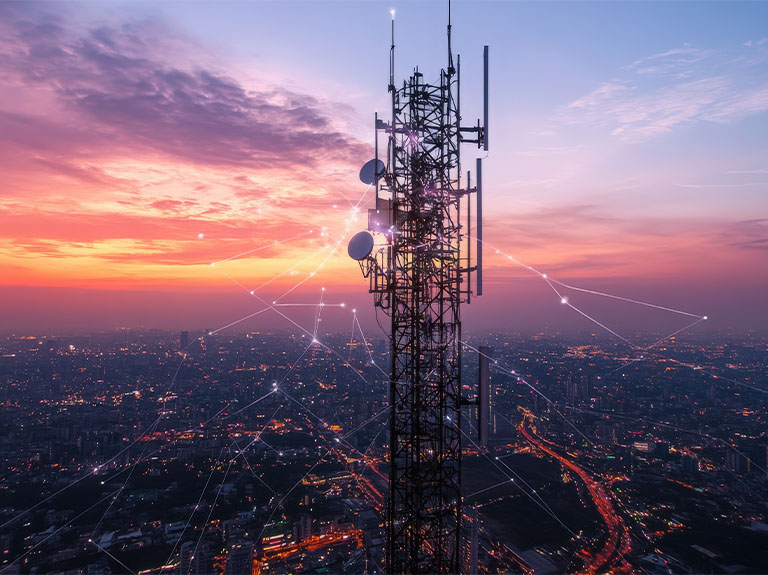5G promises to change restaurants forever.
The restaurant industry has significantly evolved over the last few decades. In the early 2000s, the Quick Service Restaurant (QSR) industry was just beginning to transform how they operate through new technologies.
It’s been an amazing transformation. It started with a few business applications – in-store Wi-Fi, cashless point of sale or “POS,” and access to sales reporting data. These foundations have taken us to the cloud applications we all experience today.
With digital menu boards, mobile POS, cloud inventory, security cameras, and mobile ordering, the industry has exploded with technology. It wasn’t long ago that the only store locator was the phone book and offers were coupons you cut out of the newspaper.
5G has the potential to change everything. And for the restaurant industry, there are 3 areas to watch:
- Latency: Latency in 5G could one day be reduced to 9-12 milliseconds round trip for some applications. Our trial with Magnolia Silos in Waco, Texas provided us a glimpse into how 5G could change retail. We observed wireless speeds of approximately 1.2 Gbps in a 400 MHz channel and RAN latency rates at 9-12 milliseconds.
- Compute: The journey we’ve been on is not just about increasing speeds, it’s about increasing compute power at the edge. The capacity and speed of the edge compute will continue to grow, but the location of the compute will change along with the ability to share that compute across multiple business applications.
- Speed: 5G peak speeds could eventually increase to multiple gigabits per second. A movie that used to take 7 minutes to download on today’s network, could take 8 seconds with multi-gigabit speeds.
Why do we need lower latency and better speeds? Why do I need to keep moving compute to the edge? Because with more data comes more opportunity.
Consider this. Data traffic on our mobile network has grown more than 470,000% since 2007. To put this into perspective, as of 3Q18, 242 petabytes of data cross the AT&T network daily. It would take roughly 2,000 years to listen to 1 petabyte of music. This is 6X more than when 4G LTE launched in 2011 and nearly double the amount of data in 2015, just 3 years ago
Video now makes up more than half of our mobile data traffic. By 2022, we estimate video could make up more than 75% of AT&T’s mobile traffic driven by growth in 4K video, autonomous cars, drones, VR/AR and mobile gaming.
And now, the digital experiences that the restaurant industry has been adopting mirror the consumer adoption of these services across our network. You’re using cloud applications and significantly more video than ever before and looking for ways to use technologies to continue to transform your restaurants.
So, why does the restaurant industry need to think about speed, latency, and compute? The macro trends we’re seeing across our network, are the same trends impacting your business.
To support the data demands of these new technologies and experiences, restaurant networks will need to deliver complex and wide-ranging network management capabilities for quality, performance, bandwidth, latency, and coverage.
As we continue to adopt new technologies in the restaurant, and as our kitchen equipment becomes connected and intelligent, it will start to communicate with other devices within the restaurant, outside the restaurant, and through the consumers’ interaction and digital journey.
A 5G Future
People have discussed using robotics in restaurants for many years, but network speeds, latency, cost, and management of these devices held many back. Moving forward with all that 5G promises, including the improved ability to move compute to a shorter distance edge that can be shared, we’ll pass a tipping point that brings this technology to a reality with real ROIs.
Virtual reality (VR) has blown up in the world of fun and entertainment. But as we increase throughput and decrease latency, VR will become a training tool within your restaurants.
Haptics, which is the ability to create a sense of touch within an application or experience, will eventually evolve to include feelings, potentially weight, and smell. Your crew may be flipping the virtual burger while feeling the tool in their hands, and hearing the food cook, while smelling the aromas. All without using your valuable inventory.
The Internet of Things (IoT) can be used for tracking food sources and improving disposal of food waste. Traffic patterns will predict food production needs to the kitchen. You’ll even have insight into when the local soccer game is going to end before the team walks into the restaurant. And IoT sensors can help make sure you have the restroom stocked with paper towels for when that post-soccer game rush hits.
Drone delivery will be real; using drones to improve the efficiency of the consumer experience is a reality. Your restaurant will be connected throughout your delivery processes enabling entirely new consumer experiences and kitchen designs. You could eventually deliver a full picnic in the park to your customers.
Content personalization and digital experiences of the future will evolve from the one-to-many experience of today’s existing menu boards, to personalized messages – customized to consumer preferences.
Artificial intelligence will help personalize the design and production of your products, anticipating customer demand and learning to predict a customer’s order in advance. For example: If you know a customer doesn’t drink coffee, your platforms, menu boards, offers, and ordering tools could someday automatically adjust to those preferences. Digital experiences will follow the consumer across their digital devices.
Speaking of the consumer experience, every ordering platform that exists today will change. With better speeds, lower latency, and shared compute - kiosks to drive-throughs will evolve into immersive, virtual language experiences, giving a new spin to how people order their food.
Laying the Foundation
For those of you wondering, “What can I do today? How do I lay the foundation for this evolution?” I offer the following suggestions:
- Embrace software-defined networking. Look for opportunities to move from purpose-driven devices to compute that can be used for multiple purposes.
- Get comfortable using cellular wireless broadband. It may seem simple but start leveraging cellular wireless broadband. Cellular wireless can be used as a primary transport and as a redundant backup to your wired network. It can augment lower speed wired services or be used to help with restaurant openings.
- Convert to cloud hosted communications & collaboration solutions. Many restaurants are still using analog POTS lines. Start converting your voice services to IP and use collaboration solutions - the future of voice in your restaurants will need it.
- Use the data you have. Data is the new oil. Digital signage, content personalization, and analytics is exploding in the industry, but the integration to consumer analytics and the personalization of content is just beginning. Have discussions with trusted companies like AT&T that can combine technology with data and analytics to help you on this journey.
- In addition, keep track of analytics to better know where your deliveries are, where your core ingredients are sourced.
- Use technology to target/market to individual consumers or a consumer demographic but, equally, start to implement tools that can track the success of these campaigns.
- Invest in restaurant dashboards. Look at each new initiative as a cohesive experience for your future restaurant. An integrated dashboard can report on a wide range of sensors to help report status of individual events and correlate the data insights derived across sensors. It isn’t about knowing when the door opened or when the car pulled into your lot; it’s about knowing how each action is going to impact your business.
We’re about to embark on an amazing transformation that has the potential to alter how we see and feel the world. When fully implemented 5G will enable better speeds, ultra-reliable low latency, and compute capabilities that will change how restaurants interact with customers and prepare meals.


